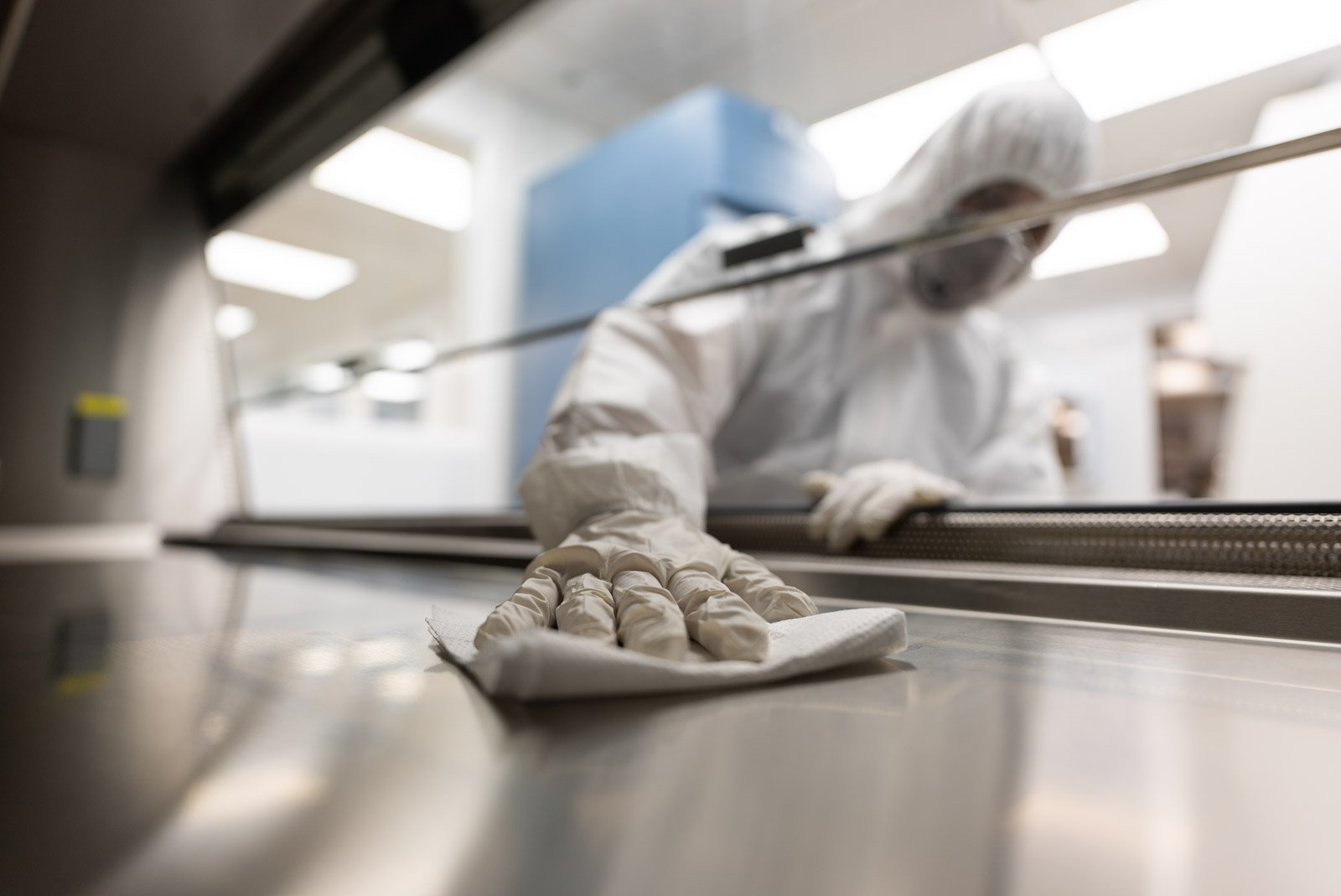Pharmacy Cleanroom Cleaning Guide
Keys to a compliant and sustainable pharmacy cleanroom
Cleaning and sanitizing pharmacy cleanroom suites and their respective equipment/enclosures to meet USP Chapter 797 and 800 requirements requires a high level of attention to detail and the use of well organized and easy to follow protocols. While the latest USP requirements can mean large investments of capital to build a compliant and functional cleanroom suite, cleaning protocols however, can be implemented at a relatively low cost. The understanding and use of proper gowning/garbing and cleaning routines can provide immediate and substantial risk reduction, but requires staff cooperation that is most easily earned through education and clear written procedures.
Set Up A Routine
When PEC’s and SEC’s are established in the pharmacy cleanroom and there is an understanding of consistent use of the proper PPE and particulate-control measures, the shortcoming of a cleaning routine can break the chain of sterility and overall cleanliness. Lapses in cleaning protocols can introduce viable particles - those of a biological nature, or allow infiltration of non-viable particles that while not biologically active, serve as transportation for micro-organisms.
Routines should be established that cover the performances of:
Daily Cleaning Checklist
Weekly Cleaning Checklist
Monthly Cleaning Checklist
For some pharmacy cleanrooms, who can afford to outsource the cleaning, will have a 3rd party professional cleanroom cleaning service assist with keeping environmental hygiene at its highest. In many hospital settings, the environmental services department may have this responsibility. But in many pharmacies, the staff cleans the controlled environment.
The most important concept is not who cleans the pharmacy cleanroom and equipment, but rather, how they clean and when. Detailed cleaning protocol training is vital towards establishing a sound routine to be implemented across the board. Periodic supervision of the cleaning in progress as well as record-keeping of the cleaning routine are required to ensure the cleaning is performed as planned and documented for compliance with USP requirements and your respective State Board of Pharmacy.
Understand Your Cleaning Agents & Solutions
Just like Education, PPE, and Routines; Cleaning and Sanitizing agents are critical to the process. The main two actions that must be performed (separately) are Cleaning and Disinfecting. Cleaning and disinfection should occur from the cleanest area to the dirtiest.
Example: ISO Class 5 -> ISO Class 7 -> ISO Class 8
Perform cleaning and disinfection from top to bottom of the space starting with ceilings, then walls, then equipment and furniture, lastly floors.
Cleaning Agents
Cleaning using a detergent or surfactant solution is for removing dirt, grime, grease, and particulates from a surface. Cleaning comes before disinfection. Consider it like cleaning at home. If you do not remove the crumbs and spills from the kitchen counter with a wet paper towel, then disinfecting with a bleach-based spray is less effective and takes more product to ensure sanitization. It is the same concept in a pharmacy cleanroom.
Disinfecting Agents
Sanitization is vital to a USP 797 compliant compounding pharmacy or hospital pharmacy. But it is one of the areas that can be very confusing when designing your cleaning protocols. For one thing, there are many types of disinfectants. They can be grouped into two general categories: oxidizing and non-oxidizing agents. Each category kills different types organisms: oxidizing agents are broad spectrum with the power to kill spores, the toughest of micro-organisms to eradicate while non-oxidizing agents are organism specific.
Non-Oxidizing agents:
Alcohols
Quaternary Ammonium Compounds (QAC or quats)
Phenolics (the FDA notes that phenolics are not preferred and they are banned for use in Canada)
Oxidizing agents:
Halogens
Peracetic acid
Hydrogen peroxide
Isopropyl alcohol (IPA) is commonly used as a sanitizing agent for surfaces in pharmacy compounding cleanrooms, but 3% hydrogen peroxide and 2% sodium hypochlorite (bleach) solutions also effectively sanitize. The Center for Disease Control (CDC) declares that a sodium hypochlorite solution of 500 ppm is effective against nearly all bio-contamination. Though many studies support bleach’s disinfectant and sterilant attributes, it does not possess the detergent action for cleaning away soil and residue.
Following manufacturer instructions is critical to ensure that dilution, storage, applying, and handling of the cleaning agents does not reduce efficacy. The correct dilution ensures that surfaces such as floors, workbenches, and compounding equipment are not damaged as they work to sanitize effectively.
Situational Cleaning Protocols
When a pharmacy cleanroom goes live for the first time from being built/installed, or perhaps the pharmacy cleanrooms was down for a period of time, or lastly, perhaps contamination is found, your facilities established cleaning protocol can be performed multiple times to reach the desired level of cleanliness and sterility. Such situational cleanings are:
Triple clean – sanitizing the critical areas and anteroom 3 times. First cleaning with a detergent-based cleaner followed by 3 disinfecting cycles: complete cleaning with 2 different disinfectants then a sporicidal agent
9-time clean – conducting the triple clean 3 times (which is an investment of time), but for worst case scenarios, it is sometimes required.
Developing Your Pharmacy’s Cleaning Protocol
Designing a pharmacy cleanroom cleaning program requires establishing many policies and procedures and educating staff.
The investment in facilities and equipment is not prudent if the efficacy of its processes and applications are not maintained correctly. Defining the SOP in rigorous detail regarding procedures, behaviors, practices, equipment, and tools to be employed by your staff is a daunting, yet critical task. Your cleanroom staff is the key to implementing policies and procedures for effective and sustainable cleanroom cleaning.
Seek support from regulatory experts, consultants, and cleanroom vendors for further help and guidance on establishing and maintaining your cleanroom environments.




